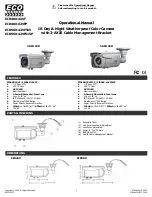
V1.02
Thom Hogan’s Complete Guide to the Nikon D300
Page 618
But even if you want to use Automatic flash mode you’ll still
find many third party flashes lacking. That’s because you’ll
often have to manually transfer ISO and aperture settings.
Thus, at present, I don’t recommend third party flashes with
the D300. There are just too many caveats. If you want an
external flash for the D300, the SB-800 is currently the best
choice. First, it’ll give you significantly more power. Second,
it will work wirelessly with the internal flash. And finally, it
adds the ability to do TTL above 1/250 (
TTL FP
), a significant
feature you’d be otherwise missing.
Studio Flash
The D300 can be connected to studio lighting by connecting
a standard PC Sync cable to the PC connector on the front of
the camera. Note that this connector, like the standard ISO
hot shoe on the camera, should be limited to voltages of
about 24 volts or less. To play it safe, you can use an isolation
connection, such as the Wein Peanut.
The Rear Sync option is only available using Speedlight units
in the hot shoe, by the way.
D300 Internal Flash
The D300 has a built-in, low-power Speedlight. This internal
flash is not automatically popped up, as it is with some other
Nikon consumer cameras. You manually control when it is
used by popping it up into position (press the Flash Release
button). If the flash is up, the flash fires. If the flash is down,
the flash doesn’t fire. So, if you don’t want flash, just push the
flash head down so it locks into the down position.
The internal Speedlight doesn’t zoom the flash head, allow
bounce, or many of the other fancy features of the external
Speedlight models, but it does provide adequate illumination
for many situations you’ll encounter, and has a couple of nifty
tricks you might not have expected. Coverage is good to
about a 17mm lens, assuming that the lens is small enough
and doesn’t block the light from the flash. There’s a tiny bit of
















































